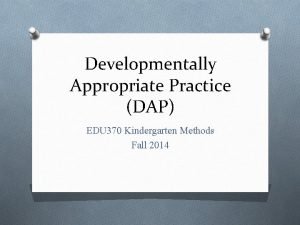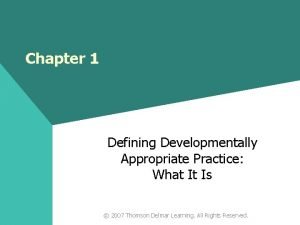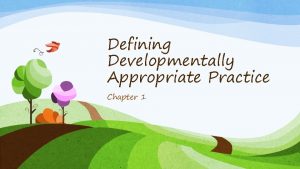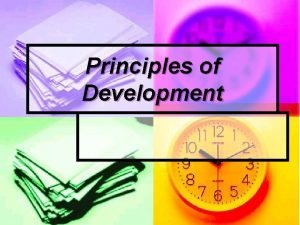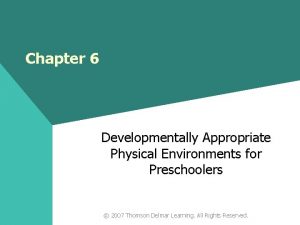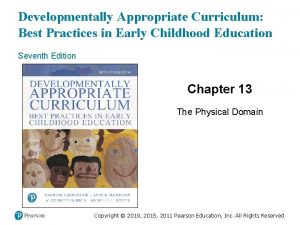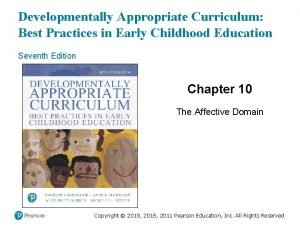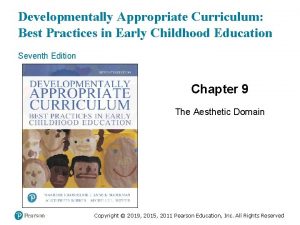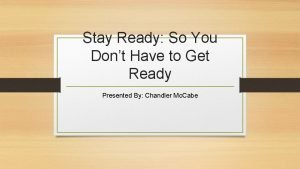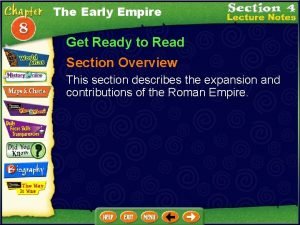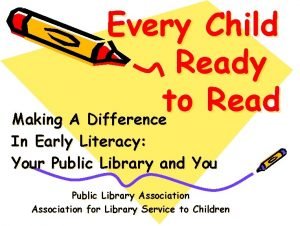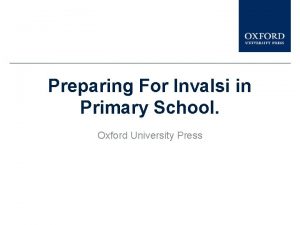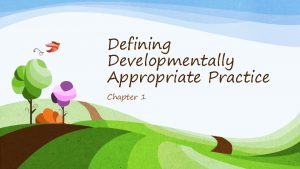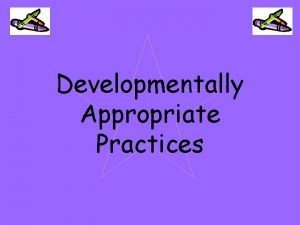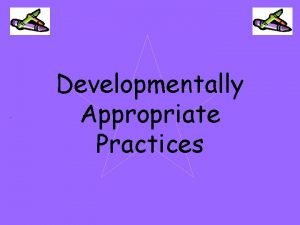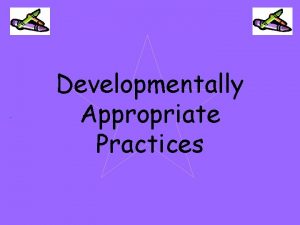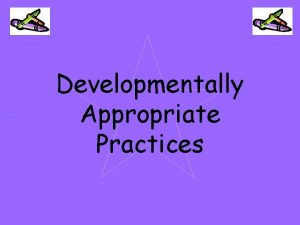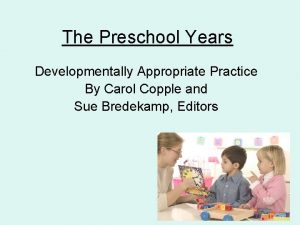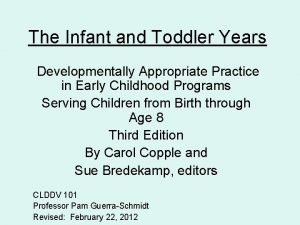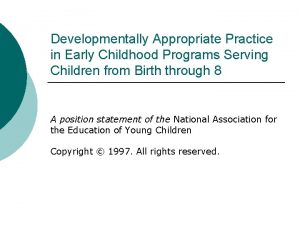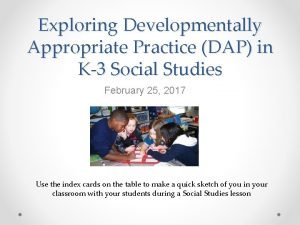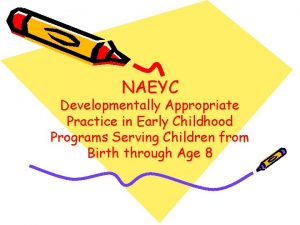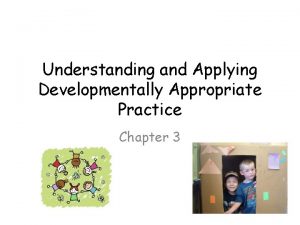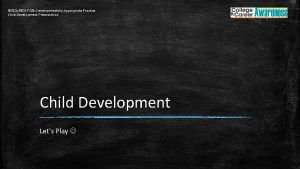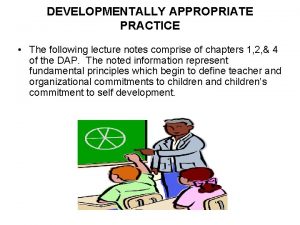Ready to Read Developmentally Appropriate Practice for Preschool




















- Slides: 20

Ready to Read! Developmentally Appropriate Practice for Preschool & Kindergarten Tammy Utchek Lee

What is developmentally appropriate practice in reading instruction? The Illinois early learning standards for 3 s and 4 s State goals #1: Read with understanding and fluency To achieve this, students should learn that: Print has a message, reading progresses from left to right and from top to bottom, that labels and signs have meaning, letters have names and can be matched with sounds, words rhyme, sounds repeat They should be able to retell a story, answer questions, and be able to discuss the story.

The Illinois Early Learning Standards for Kindergarten For state goal #1: Read with understanding and fluency To achieve this, students should learn: Print has a message; print proceeds from left to right; there are words, letters, and spacing; phonological awareness; phonemic awareness; knowledge of letters and common sounds; read one-syllable and high frequency words

DAP According to the Joint Position Statement of the International Reading Association and NAEYC Why should we provide early instruction in reading? • Birth to age eight is the most important period for literacy development. • Literacy is critical to school and life success • Our society has expectations beyond minimal standards of literacy

How do appropriate practices differ from the traditional, whole group instruction approach? Drill-and-practice is not suitable for all ages. Young children need meaningful experiences that build on prior knowledge. What does the research tell us? The ability to read does not develop naturally. No one instruction strategy works for all children.

What do preschoolers need to know? • • • The alphabetic system, letter-sound relationships Linguistic awareness, such as through rhyming and word games Phonemic awareness, recognizing words as individual sounds What do kindergarteners need to know? • • • Those concepts listed above as well as. . . Letter naming Word naming

How do these standards guide my teaching? Explicit, targeted reading instruction must take place Many of the connections that make reading possible, such as letter to sound, are not just “picked up. ” Those few students who learn to read on their own still need instruction. While not the only approach or sufficient for reading, phonics instruction is an integral part.

What concepts do I teach and why? Preschool: The building blocks for kindergarten reading instruction The most common letter sounds Begin to merge sounds Other things that are “givens”: a print-rich environment many varied group and individual reading experiences songs/activities that incorporate word play, stressing syllables, rhyming, beginning sounds, etc. modeling of reading and writing knowing when each child is developmentally ready

Kindergarten: What they need to know before they leave (my goals) They should be able to read most kindergarten sight words. They should be able to “sound out” most three-letter words. They should be able to read beginning sentences.

Helping Students Attain Success in Reading Students receive individual, small group and/or whole group reading instruction focusing on 6 main concepts: 1. 2. 3. 4. 5. 6. Letter to sound association Merging sounds to form 3 -letter words Sight words Blends and Digraphs Long vowel sounds Other concepts, such as double consonants

Letter Sounds: How I Teach Them 1. 2. 3. 4. 5. Through whole group games, such as “Secret Sound” With board games like “The Path to Reading” Letter/picture cards and puzzles Songs Circle activities, such as letter cards Key points to remember: Always teach the most common/easiest sounds first, such as short vowel sounds and the first letter of their name Repetition is the key Letter/sound knowledge is the firm foundation of reading and writing


Merging Sounds: How I teach students to read 3 -letter words 1. 2. 3. 4. 5. Word puzzles based on word families Beginning reading books, such as Tam or Bob books With games like “Guess My Word” Group games, such as “Secret Sound” Sentence puzzles Key points to remember: This is the hardest concept in reading: Once students get this, they are off and running! Easier to read ca--t than c--at

Sight Words are taught through: 1. 2. 3. 4. 5. Group games, like “Secret Sight Word” Beginning reading books Games, like “Sight Word Matching” or “Zoom” Sentence puzzles Poems of the week Key points to remember: This REQUIRES very explicit instruction and LOTS of repeated exposure. The list of which words to teach always varies.


Blends and Digraphs 1. 2. 3. 4. Word puzzles Individual lessons Beginning reading books Games, such as “Go Fishing” and “Reading Tic-Tac-Toe” Key points to remember: Students usually pick up this concept easily. Teach a few blends and digraphs and the rest fall into place. Students can still be gaining proficiency in reading 3 -letter words as they learn.

Long Vowel Sounds 1. 2. 3. 4. Word puzzles that make 3 letter words into long vowel words by adding the silent e Individual lessons Beginning reading books Games, such as “Reading Tic-Tac-Toe” Key points to remember: This concept is hard. Students will use short vowels at first. Teach the basic patterns, silent e and double vowels. This can be introduced while they are still working on blends/digraphs.

Such as: 1. 2. 3. 4. 5. Other Concepts Double consonants Sound of ou and ow Double oo Y at the end of a word -ing and -ed endings Key points to remember: At this point, they pick up a lot of the irregulars on their own. These concepts are advanced, teaching them is just “gravy”.

Key Points to Remember 1. Help each student obtain a firm grasp of the letter sounds. 2. Make sure the child is reading and not guessing, using solely visual recognition, and/or simply retelling a familiar story. 3. Have high expectations of your students. 4. Show them your love of reading. 5. Be developmentally appropriate in your teaching approaches. 6. Have fun with your students!

Additional Resources www. Teacher. Tams. Toolbox. com My own site where you’ll find resources I developed to use in my classroom. Check out the conference page and the FREE page! www. kinderreaders. com They have great beginning reading books. Each one comes in 4 levels. www. kindergarten. com Here you’ll find sets of books for emergent readers that are arranged by theme. ü ü “Bob Books” by Bobby Lynn Maslen Beginning Science readers by Scholastic Sight Word Books Published by Crystal Springs Books Math Games for the Overhead and Reading Games for the Overhead by Scholastic
 Dap kindergarten
Dap kindergarten Definition of developmentally appropriate
Definition of developmentally appropriate Define developmentally appropriate practice
Define developmentally appropriate practice Principles of developmentally appropriate practice
Principles of developmentally appropriate practice Developmentally appropriate environment
Developmentally appropriate environment Developmentally appropriate curriculum 7th edition
Developmentally appropriate curriculum 7th edition An appropriate developmental curriculum
An appropriate developmental curriculum Developmentally appropriate curriculum 7th edition
Developmentally appropriate curriculum 7th edition Stay ready to keep from getting ready
Stay ready to keep from getting ready Read ready
Read ready Every child ready to read six skills
Every child ready to read six skills Oxford invalsi inglese
Oxford invalsi inglese Kontinuitetshantering
Kontinuitetshantering Typiska novell drag
Typiska novell drag Tack för att ni lyssnade bild
Tack för att ni lyssnade bild Vad står k.r.å.k.a.n för
Vad står k.r.å.k.a.n för Varför kallas perioden 1918-1939 för mellankrigstiden?
Varför kallas perioden 1918-1939 för mellankrigstiden? En lathund för arbete med kontinuitetshantering
En lathund för arbete med kontinuitetshantering Underlag för särskild löneskatt på pensionskostnader
Underlag för särskild löneskatt på pensionskostnader Tidbok
Tidbok A gastrica
A gastrica
